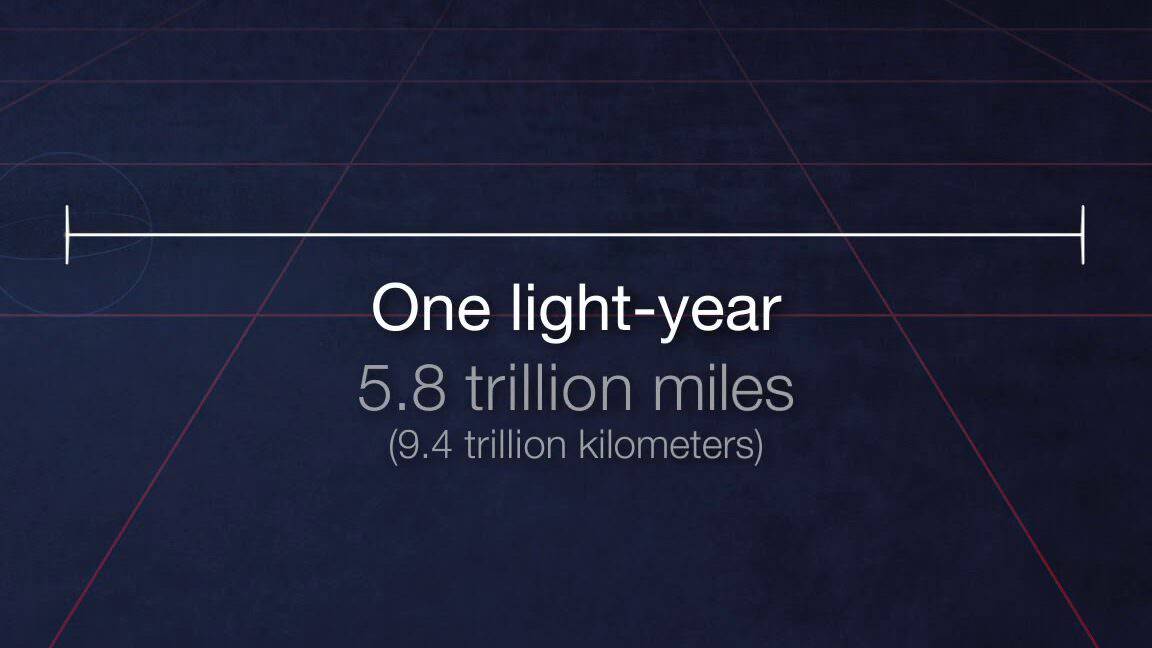Measuring the immense expanse of space in kilometers or miles can be a challenging task. Scientists have been contemplating alternative units of measurement for vast distances. Light-years are often mentioned in science fiction literature and movies, but the concept may not be clear to everyone. Some individuals struggle to comprehend how it differs from a standard Earth year.
What is the definition of a light year?
In the field of astronomy, just like in any other scientific discipline, there exists a unique set of terms that may appear peculiar and unintelligible to individuals not well-versed in the subject matter. What exactly is dilation? And what about perigee? Can pulsars and quasars be considered synonymous or distinct entities? Frequently, those with an interest in astronomy pose the following inquiry: what precisely is a light year?
Individually, these two terms make sense, but when used together, they become perplexing. “Light-year” – a unit of measurement for what? Time? It would be helpful to know the specific length of a light-year in terms of our normal Earth years. In other words, how many Earth years does it take to equal one light-year? On the other hand, many people have observed that this term is often used when discussing the distances of objects in space. For instance: “The center of the Milky Way is located 30,000 light-years away” or “Sirius is situated 8.6 light-years away.” This raises the question of how distance can be expressed in terms of time.
Let’s attempt to answer this question in the simplest way possible.
A light-year is a unit of distance
First and foremost, it is important to grasp the concept that a light-year is not a unit of time but rather a unit of distance in the field of astronomy, similar to a meter, kilometer, mile, or arc second in everyday life. To comprehend this, one must recall how distance can be measured when direct tools like rulers or compasses are not available.
As you may know, the distance traveled by an object is equal to its velocity multiplied by the time it takes to travel (or s = v × t).
Now, let’s imagine that you are walking towards a store that is exactly three kilometers away from your location. Furthermore, let’s assume that you are walking at a constant speed of three kilometers per hour. Here’s the question: How long will it take you to reach the store? Clearly, it will take you one hour! Therefore, you can state that the distance to the store is three kilometers, or you can express it as 1 “man-hour”.
However, nobody calculates distance in “man-hours” because we all walk at different paces. Additionally, individuals have different walking styles: when they are running late for the tram, they almost sprint, but they stroll leisurely in the park. Consequently, the time t required to cover the distance to the store will also vary.
Nevertheless, what if the speed of a moving object remains constant at all times? Would it not matter where it is going, in which direction, or under what circumstances it is measured? In such a scenario, the distance could be determined by the duration of motion, as the velocity v in the equation remains constant and the distance s solely relies on the time t.
Hold on a moment, you might ask, is there an entity that is always – I mean, always! – moving at a constant speed?
There exists an object, and it possesses a unique quality! It is common knowledge that the velocity of light in a vacuum remains constant at 299,792 kilometers and 458 meters per second, which can be rounded to 300000 km/s.
Consequently, a ray of light can traverse a distance of 300000 kilometers within a single second! Remarkable, isn’t it? If we can somehow determine the precise duration it takes for light to reach an object, we will be able to ascertain its distance!
What is the method for achieving this? As an example, we could utilize a high-powered laser to direct it towards the moon. When the laser beam reaches the Moon, a portion of the light will reflect off its surface and return back to Earth. Once it reaches our eyes, we will be able to observe the beam of light on the Moon. By accurately measuring the duration between activating the laser and the appearance of the beam on the Moon’s surface, and then multiplying that duration by the speed of light, we can determine the distance the laser covers to reach the Moon and return. Dividing this total distance in half will provide us with the precise distance to the Moon!
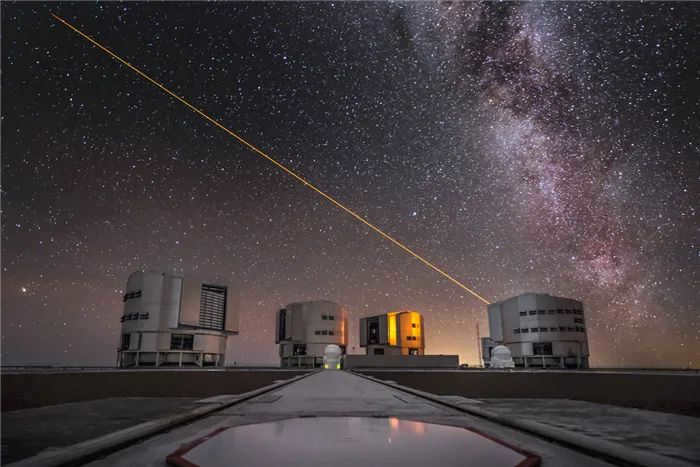
The atmosphere causes a slight delay in the speed of light, which is why astronomers use a laser beam to create an artificial star in the sky. By assessing the state of the atmosphere through this artificial star, scientists can measure distances in the solar system with great precision. In the 20th century, one method used to measure distances was by locating Venus through radio signals. The scientists would send a radio signal to the planet and carefully measure the return time. Using the formula s = v × t, they could then calculate the distance between Earth and Venus. Today, we have achieved such measurements with an accuracy of a few meters.
What is the equivalent of 1 light-year?
Let’s go back to where we started. A light-year is the distance that light (which always – always! – travels at a consistent speed of 300,000 km/s) covers in exactly one year!
Interestingly enough, that is quite a large distance, isn’t it? If light travels 300,000 kilometers per second, it covers 60 times that in one minute – 18 million kilometers. So in one hour, it covers 1 billion 80 million kilometers! (So, we have also determined what an “hour of light” means! And in the process, we have calculated the speed of light in km/h!)
The most crucial condition for such a calculation is that the gravitational field has no effect on light. This condition is met in a vacuum. In a vacuum, the velocity of electromagnetic rays remains constant.
The distances to the stars are vast and necessitate a means of measurement. Ordinary kilometers are minuscule in comparison, as even the distance from Earth to the Sun averages 150 million kilometers, and is significantly greater on many other planets. This is why we utilize measurements such as light-years and parsecs for extremely large distances.
Article on the subject: “Pyaterochki” and “Perekrestki” now offer the ability to pay for purchases with just a glance. Learn how to use the self-service checkout at Pyaterochka.
Many individuals mistakenly conflate the earth year with the light-year. The former measures time, with one year being equal to 365 days, during which the Earth completes a single orbit around the Sun. Therefore, this concept has no relevance to the measurement of distances.
A light-year is a unit of measurement that equals 9,460,730,472,572,580,800 meters, representing the distance traveled by a beam of light in one Earth year.
Due to the constant and precise speed of light in a vacuum, it is an ideal tool for measuring vast distances. Other units of measurement include:
- 1 second of light is equivalent to 299,792.458 kilometers.
- 1 minute of light is equivalent to 17,987,547.48 kilometers.
- 1 hour of light is equivalent to 1,079,252,848.8 kilometers.
- 1 day of light is equivalent to 25,902,068,371.2 kilometers.
- 1 light week is equivalent to 181,314,478,598,598.4 kilometers.
- 1 light month is approximately 790 billion kilometers, as the exact length of a month is not known.
These measurements are based on the distance covered by light in a specific time frame, such as a second or a minute. This distance is estimated to be around 300,000 km/s.
For example, it takes approximately 1.3 light seconds for light to travel from the Earth to the Moon. Similarly, the distance from the Earth to the Sun is approximately 8 minutes and 20 light seconds. As for the Voyager spacecraft that departed the solar system, it is estimated to be around 14 light hours away.

The Advantages of Light Years in Astronomy
In order to accurately measure distances to other stars, nebulae, and galaxies, astronomers employ the use of light years. If these astronomical distances were measured in kilometers, the resulting values would be astronomical themselves, consisting of an enormous number of zeros. While kilometers are suitable for measuring distances within the solar system, where millions and billions of kilometers are involved, they are inadequate for measuring interstellar distances. It is akin to using millimeters to measure the distances between cities.
Related Article: Applications for Verifying the Authenticity of Alcohol and Excise Stamps.
A light year is an incredibly large unit of measurement. However, even though it may seem immense, the nearest star to us is still over 4 light years away, while some stars are hundreds or even thousands of light years away. Take the Orion Nebula, for instance, which is located 1,300 light years from us, and the center of the Milky Way, which is a whopping 26,000 light years away. Our very own galaxy spans a distance of 100,000 light years. To put the distance to the Orion Nebula in perspective, it would equate to a mind-boggling 12,651,000,000,000,000,000,000,000,000,000,000,000,000,000,000,000,000,000,000 kilometers. Light years truly offer a convenient way to measure such vast distances.
However, light years also prove useful for measuring intergalactic distances, which, although still immense, pale in comparison to the distances between galaxies. For example, the Andromeda Galaxy is located 2.5 million light years away, but beyond that, everything is much farther away, typically measured in billions of light years.
However, our ability to observe the universe is limited to a distance of 13.8 billion light years. This is the age of the universe, and any object beyond this distance would be too ancient for us to see.
A different unit of measurement
While light years are commonly used to measure cosmic distances, they are still relatively small in the grand scheme of things. This is why astronomers use a different unit called the parsec.
A parsec is equivalent to 3.26 light years or roughly 30.8568 trillion kilometers.
The term “parsec” is derived from the combination of the words “parallax” and “second”. In practical terms, it represents the distance from which an orbital radius of 150 million kilometers appears as a tiny fraction of a second. By performing simple calculations, scientists were able to determine the length of a parsec.
However, the parsec itself is not a very large measurement. The distance to the nearest star, Proxima Centauri, is 4.3 light-years, or only 1.3 parsecs. Kiloparsecs, which are thousands of parsecs, and megaparsecs, which are millions of parsecs, are used for larger distances. They are denoted as kpc and mpc. Therefore, the distance to the Andromeda Galaxy is 2.5 light-years or 0.77 Mpc. The distance to the horizon of the observable Universe is 4 Gpc (gigaparsecs or billions of parsecs).
As you are aware, scientists invented an astronomical unit to measure the distances from the Sun to the planets, as well as between planets. And what exactly is a light year?
First and foremost, it should be noted that the light year is also a unit of measurement used in astronomy, but not for time (despite the word “year”), but for distance.
What is the equivalent of a light year?
When scientists were able to calculate the distances to the nearest stars, they realized that using the astronomical unit was inconvenient in the stellar world. For instance, the distance from the Sun to the closest star is approximately 4.5 light-years. This implies that it takes 4.5 years for light from our Sun to reach the nearest star, which is called Proxima Centauri. So, how vast is this distance? Let’s skip the math and just note that light particles travel at a speed of 300,000 kilometers per second. Therefore, if you were to send a flashlight signal to the Moon, it would be visible there in less than one and a half seconds. It takes 8.5 minutes for light to travel from the Sun to the Earth. So, how many light rays travel in a year?
Let’s admit it: a light year is approximately 10 trillion kilometers. (a trillion is a number with twelve zeros). To be more precise, it is 9,460,730,472,581 kilometers. If we convert it to astronomical units, it will be around 67,000. And this is only for the closest star!
It is evident that in the realm of stars and galaxies, the astronomical unit is not suitable for measurements. It is more convenient to work with light-years in calculations.
Relevance in the celestial realm
As an illustration, the distance between Earth and the most luminous star in the sky, Sirius, amounts to 8 light-years. Similarly, the distance from the Sun to Polaris measures approximately 600 light years, which implies that it takes 600 years for light to travel from us to that point. This distance can be roughly equated to 40 million astronomical units. To put this into perspective, our Galaxy, known as the Milky Way, has a diameter of about 100,000 light years. In comparison, our closest cosmic neighbor, a spiral galaxy referred to as the Andromeda Nebula, is situated 2.52 million light years away from Earth. Expressing this distance in astronomical units would be highly inconvenient. However, there exist celestial objects that are situated as far as 15 billion light years away from us. Consequently, the radius of the observable Universe is estimated to be 13.77 billion light years. Furthermore, the entire Universe, as we currently comprehend it, extends beyond the observable portion.
Incidentally, the size of the observable Universe is not simply twice the radius, as one might assume. This is due to the fact that the universe is constantly expanding. Over the course of 13.77 billion years, the light emitted by distant objects has traveled even further away from us. Presently, these objects are more than 46.5 billion light-years away. By doubling that distance, we arrive at a true diameter of 93 billion light-years for the observable Universe. As a result, the size of the observed portion of the cosmos, also known as the Metagalaxy, is continually increasing.
Attempting to measure such vast distances in kilometers or astronomical units is nonsensical. Frankly speaking, even light-years do not quite suffice. However, no better unit of measurement has yet been devised. The numbers involved are so immense that only a computer is capable of handling them.
Therefore, the light year (sv. yr.) is a unit of measurement for distance, not time, signifying the distance covered by a ray of sunlight over the course of a year, specifically 365 days. This particular unit of measure is highly practical due to its clarity, enabling us to determine the time it takes to receive a response when transmitting an electromagnetic message to a specific star. If this timeframe happens to be excessively lengthy (e.g. a thousand years), then it becomes futile to engage in such actions.
Throughout centuries of exploring their own planet, humans have devised numerous systems for measuring distances. Eventually, it was unanimously decided to adopt the meter as the universal unit of length, with long distances measured in kilometers.
However, in the 20th century, a new challenge arose for humanity. A close examination of the cosmos revealed that the vastness of the Universe is so immense that kilometers are inadequate for measurement. While distances such as from Earth to the Moon or Earth to Mars can still be expressed in familiar units, attempting to determine the number of kilometers to the nearest star results in an astronomical figure with an unimaginable amount of decimal places.
What is the equivalent of 1 light-year?
It was evident that the exploration of outer space required a new unit of measurement, and thus the concept of a light-year was introduced. In a single second, light can travel an astonishing 300,000 kilometers. A light-year is defined as the distance that light can traverse in the span of one year – and, to put it in more relatable terms, that distance equates to a staggering 9,460,730,472,580.8 kilometers. Clearly, it is far more convenient to use the concise term “one light-year” rather than constantly referencing this immense figure in calculations.
Proxima Centauri is the closest star to us, located just 4.22 light-years away. In terms of kilometers, this distance is incredibly vast. However, everything is relative – when considering that the nearest galaxy, Andromeda, is a staggering 2.5 million light-years away from the Milky Way, Proxima Centauri starts to appear as a remarkably close neighbor.
How many Earth years are in 1 light year?
Many people mistakenly believe that a light year is a unit of time. However, this is not the case. The term “light year” actually refers to the distance that light travels in one Earth year, and has no correlation to the passage of time.
A light year is defined as the distance that light travels in one year. The International Astronomical Union has provided the definition of a light year as the distance that light travels in a vacuum, unaffected by gravity, over the course of a Julian year, which is equivalent to 365 days. This is the accepted definition used in scientific literature.
In professional literature, distances are often calculated in parsecs or kilo- and megaparsecs.
There are specific measurements for distances in light hours, minutes, days, and so on.
- The distance of a light year is equivalent to 9,460,800,000,000,000 kilometers,
- A month is approximately 788,333 million kilometers,
- A week is about 197,083 million kilometers,
- Per day is around 26,277 million kilometers,
- An hour corresponds to 1,094 million kilometers,
- A minute is roughly 18 million kilometers,
- A second is approximately 300,000 kilometers.
That’s fascinating! It takes an average of 1.25 seconds for light to reach the Moon from the Earth, and a little over 8 minutes to reach the Sun.
The star Betelgeuse, located in the Orion constellation, is expected to explode in the near future.
Betelgeuse is situated between 495 and 640 light years away from us. If it were to explode right now, the explosion would not be visible to Earth’s inhabitants for another 500 to 600 years.
And in the event that you witness the occurrence of the explosion in the present day, please bear in mind that the explosion in actuality occurred during the era of Ivan the Terrible…
Earth’s Orbital Period
An Earth year is the duration it takes for the planet Earth to complete one orbit around the sun. When considering all pertinent calculations, it can be determined that one light year is equivalent to 63,242 Earth years. It is important to note that this measurement specifically pertains to the Earth, as the figures for other celestial bodies such as Mars or Jupiter will differ significantly. A light year is a unit used to measure the distance between two objects in outer space. Despite both measurements referring to distance, the numerical values for light years and Earth years differ greatly.
Scale
The concept of scale refers to the size or proportion of an object or event in relation to something else. It can be used to describe the physical dimensions of an object, such as its height or width, or the magnitude of an event, such as the intensity of an earthquake. Scale is often used to compare and contrast different objects or events, and can be represented using various units of measurement, such as inches, feet, or miles. Understanding scale is important in many fields, including architecture, engineering, and geography, as it allows for accurate representation and analysis of the world around us.
Video
Sources
We often receive very interesting questions that have unconventional answers.
One of these questions can be seen in the title. Indeed, how many Earth years are there in one light year? You may be disappointed, but there is no definitive answer.
The truth is that a light year is not a unit of time, but a unit of distance. To be more precise, a light year is the distance that light travels in a vacuum in one Julian year (equivalent to 365.25 standard days or 31,557,600 seconds) according to the International Astronomical Union.
- 1 light month is approximately equal to 788,333,000,000,000 kilometers
- 1 light week is approximately equal to 197,083,000 kilometers
- 1 light day is approximately equal to 26,277 million kilometers
- 1 light hour is approximately equal to 1,094 million km
- 1 light minute is approximately equal to about 18 million km
- 1 light second is approximately equal to 300 thousand km
To determine the number of kilometers per light-year, you can use a simple web calculator.
Enter the number of light years you want to convert in the left field. The result of the calculation will be displayed in the right field. Click the appropriate link to convert light years or miles to other units of measurement.
What does “bright summer” refer to?
The term “bright summer” refers to the concept of a light-year, which is the distance that light travels in one July year (365.25 days) in a vacuum.
This term is commonly used in the fields of science and fiction, and professionals often use the term “parsecs” with the prefixes “kilo” and “mega” to describe these distances.
It wasn’t until 1984 that the term “bright summer” was understood as the distance light travels in a tropical year. Since then, the value has changed by 0.002%, but this difference is not practically significant due to the lack of precise measurements in bright summers. The speed of light is approximately 300,000 kilometers per second.
The speed is measured in kilometers per second and a light year is approximately 10 trillion kilometers (9460.8800 million km). Speaking of distances, for instance, Sirius is located at a distance of 8 light-years from the nearest point to the star Proxima Centauri, which is 4.22 light-years away. Additionally, the diameter of our galaxy, the Roman Road, is 100,000 light-years.
What is a “kilometer”
A kilometer (km, km) is a unit of measurement for distances that is commonly used worldwide.
It is equivalent to 1000 meters, 0.621 miles, 0.9374 miles, 1094 yards, 3281 feet, 1.057 x 10 – 13 light years, and 6.67 x 10 – 9 astronomical units.
Distances in the Universe
Throughout history, individuals have devised various methods to measure distances, leading to the establishment of the meter as a universal unit and the adoption of kilometers as a standard unit of measurement for longer distances.
However, in the twentieth century, as humanity delved deeper into the exploration of the universe, a new predicament arose. It became apparent that the vastness of the cosmos exceeded the capabilities of miles to accurately represent these astronomical distances.
While conventional units can adequately express the distance between the Earth and the Moon, or even between the Earth and Mars, they fall short when attempting to quantify the vast expanse between our planet and the nearest star. The resulting number grows exponentially, necessitating an increasing number of digits after the decimal point.
It became evident that a fresh unit of space exploration was required – and that unit came to be known as the light-year.
Within one second, light can cover a distance of 300,000 kilometers. A light-year — is the distance that light can travel in precisely one year, and when converted into a more familiar numerical system, this distance amounts to 9,460,730,472,580.8 kilometers. It is apparent that the use of the concise “simple flight” is far more convenient than utilizing enormous numbers in calculations.
Out of all the stars closest to us – Proxima Centauri – it is only “4.2 light-years” away. Naturally, this amounts to an inconceivable figure in terms of kilometers. However, everything is relative – considering that the closest galaxy, Andromeda, is separated from the Roman road by a distance of 2.5 million light years, the star and the truth begin to appear as very close neighbors.
By the way, the utilization of light-years aids scientists in comprehending the areas in space where it is plausible to locate intelligent life and the areas where it would be fruitless to transmit radio signals.
Because the velocity of a radio signal is comparable to that of light, it is logical to anticipate that a salutation transmitted towards a far-off galaxy will arrive at its destination after millions of years. It is reasonable to expect a reply from nearby “neighbors” – entities whose hypothetical response signals would reach Earthly devices within a human lifespan.
How many Earth years is equivalent to 1 light year?
There is a widespread misconception that a light year is a measure of time.
However, this is not true. A light year does not have any relation to Earth years and it solely represents the distance that light travels in the span of one Earth year.
In our everyday lives, we often need to measure distances – whether it’s to the nearest grocery store, a relative’s house in another city, or elsewhere. However, when it comes to the vast expanses of outer space, using familiar units like kilometers becomes highly impractical. The issue here is not just the difficulty in comprehending the resulting enormous values, but also the sheer number of digits involved. Even writing out such a large number of zeros becomes a challenge. For instance, the shortest distance between Mars and Earth is approximately 55.7 million kilometers – that’s six zeros! And Mars is considered one of our closest celestial neighbors. So, how do we handle the unwieldy numbers that arise when calculating distances to even the nearest stars? This is where the concept of a light year becomes crucial. But what exactly is a light year? Let’s explore that now.

The formation of measurement units was relatively simple: each subsequent unit was made up of smaller units (such as centimeters, meters, kilometers, etc.). However, the concept of the light year was different. It was based on the understanding that the speed of light in a vacuum is constant and represents the maximum speed allowed by modern relativistic physics. This understanding led to the definition of a light year as the distance traveled by light in one Earth calendar year. In terms of kilometers, a light year is approximately equal to 9.46*10^15 kilometers. Interestingly, it only takes a photon about 1.3 seconds to reach the nearest moon, and about eight minutes to reach the Sun. However, it would take around four light years for a photon to reach the next closest stars, such as Alpha Centauri.

Wow, what an incredible span! In the field of astrophysics, there exists an even grander scale of space. The light-year, which is approximately one-third of a parsec, serves as a monumental unit of measurement for interstellar distances.
The velocity at which light travels varies under different circumstances.
By the way, there is an additional aspect regarding the movement of photons in different mediums. We are already aware of their velocity in a vacuum. When we refer to a light year as the distance traveled by light in a year, we are referring to its travel through empty space. However, it is intriguing to note that the speed of light can vary in other conditions. For instance, in the presence of air, photons tend to propagate at a slightly slower pace compared to a vacuum. The exact reduction depends on the specific atmospheric conditions. Consequently, if light were to traverse a medium filled with gas, the distance covered in a light year would be slightly less. Nevertheless, this discrepancy would not be significantly substantial.
The latest content in the section:
The measurement of a light year is defined as the distance that light can travel in the span of one year. According to the International Astronomical Union, a light year is calculated as the distance that light can travel in a vacuum, unaffected by gravity, over the course of a Julian year, which is equivalent to 365 days. This is the accepted interpretation within scientific literature.
When it comes to professional literature, the distance is often measured in parsecs, as well as kilo- and megaparsecs.
Specific numerical values have been assigned to measure the distance of light in terms of hours, minutes, and days, among others.
- One light year is equal to 9,460,800,000,000,000,000 kilometers,
- One month is equivalent to 788,333 million kilometers
- One week is equal to 197,083 million kilometers,
- One day is measured at 26,277 million km,
- One hour is approximately 1,094 million kilometers,
- A minute is approximately equal to a distance of 18 million kilometers.
- A second is approximately equal to a distance of 300,000 kilometers.
That’s fascinating! It takes an average of 1.25 seconds for light to reach the Moon from the Earth, and a little over 8 minutes for it to reach the Sun.
The star Betelgeuse, located in the Orion constellation, is expected to explode in the near future.
Betelgeuse is situated between 495 and 640 light years away from us.
If it were to explode right now, the inhabitants of Earth would not see the explosion until 500 to 600 years from now.
So, if you were to witness the explosion today, keep in mind that it actually occurred during the time of Ivan the Terrible…
Duration of One Earth Year
The duration of one Earth year is determined by the distance traveled by the Earth in that time period. It is important to note that this calculation is specific to our planet. For instance, when comparing Earth years to light years, we find that one light year is equivalent to 63242 Earth years. However, it is worth mentioning that this figure varies significantly for other celestial bodies like Mars or Jupiter. In essence, a light year measures the distance between two celestial objects, whereas an Earth year focuses solely on the Earth’s journey. Despite both terms referring to distance, their numerical values differ greatly.
Video
Sources
We often receive very interesting questions that have unconventional answers.
One of those questions is the one mentioned in the title. How many earth years are there in one light year? Unfortunately, there is no definitive answer to this question.
The reason for this is that a light year is not a unit of time, but rather a unit of distance. More specifically, a light year is the distance that light travels in a vacuum in one Julian year (equivalent to 365.25 standard days or 31,557,600 seconds) according to the International Astronomical Federation.
To accomplish this, we utilize the benchmark of 300,000 kilometers per second (which is precisely the speed of light) and multiply it by 31.56 million seconds (the number of seconds in a year), resulting in a staggering figure of 9,460,800,000,000,000 kilometers (or 9.46 million kilometers). This extraordinary number equates to the distance of one light year.
- 1 light month is approximately equal to 788,333,000,000,000 kilometers
- 1 light week is approximately equal to 197,083,000 kilometers.
- 1 light day is approximately equal to 26,277 million kilometers
- 1 light hour is approximately equal to 1,094 million km
- 1 light minute is approximately equal to about 18 million km
- 1 light second is approximately equal to 300 thousand km
In order to determine the number of kilometers in a light year, you can utilize a straightforward online calculator.
To convert a number of light years, enter the desired value in the left field. The result of the conversion will be displayed in the right field. If you want to convert light years or miles to other units of measurement, simply click on the corresponding link.
What does “bright summer” mean?
A light-year (St., ly) is the distance that light travels in a vacuum during one Julian year (365.25 days).
This term is commonly used in the fields of science and fiction, and in professional settings, the term “parsecs” with the prefixes “kilo” and “mega” is often used.
The speed of light is about 300,000 kilometers per second and a light year is approximately 10 trillion kilometers (9,460.8800 million km). When it comes to distances, for instance, Sirius is located 8 light-years away from the nearest star Proxima Centauri, which is 4.22 light-years away, and the diameter of our galaxy, the Milky Way, is 100,000 light-years.
What is a “kilometer”
A kilometer (km, km) is a unit of measurement for distances that is commonly used globally.
It is equivalent to 1000 meters, 0.621 miles, 0.9374 miles, 1094 yards, 3281 feet, 1.057 x 10 – 13 light years, and 6.67 x 10 – 9 astronomical units.
Light years
For centuries, individuals have been inventing various systems to measure distances. Initially, a universal unit of one meter and the kilometer measurement were adopted.
However, in the 20th century, a new challenge arose as humanity started exploring the universe. It became evident that the size of the universe was so vast that miles were inadequate.
While conventional units can express the distance from Earth to the Moon or Mars, determining the distance to the nearest star results in an exponentially increasing number requiring numerous decimal places.
What Does 1 Light-Year Represent?
A new unit of measurement was necessary for space exploration, and that unit became known as the light-year.
Light travels 300,000 kilometers in just one second. A light-year — represents the distance that light can travel in a full year, which is equivalent to 9,460,730,472,580, 8 kilometers when converted into a more familiar number system. Clearly, using the compact term “light-year” is much more convenient than dealing with incredibly large numbers in calculations.
By the way, the utilization of light-years aids researchers in comprehending the regions of the universe where it is plausible to encounter sentient beings and those areas where sending radio signals would be utterly futile.
Considering that the velocity of a radio signal is comparable to that of light, transmitting a salutation to a far-off galaxy would take millions of years to arrive. It is logical to anticipate a reply from nearby “neighbors” – entities whose potential responsive signals could reach terrestrial devices within a human lifespan.
How many Earth years are equivalent to 1 light year?
There is a common misconception that a light year is a unit of time.
However, this is not the case. A light year actually represents the distance that light travels in one Earth year and is not related to units of time.
In order to understand the concept of a “light year”, it is important to recall the principles of physics, particularly the section that discusses the speed of light. The speed of light in a vacuum, where it is unaffected by external factors such as gravitational and magnetic fields, suspended particles, and refraction through transparent mediums, is 299,792.5 kilometers per second. It is important to note that in this context, “light” refers to the electromagnetic radiation that is visible to the human eye.
The light month, week, day, hour, minute, and second are lesser-known units of measurement for distance.
For a considerable period, light was believed to be an infinite quantity, and it was the astronomer Olaf Remer in the 17th century who first calculated the approximate speed of light in a vacuum. Although his calculations were only rough estimates, the significance lies in the fact that he was able to determine the final value of speed. It was not until 1970 that the speed of light was accurately determined to be one meter per second. No further improvements in accuracy have been made due to challenges with the meter standard’s margin of error.
Measuring Distances: Introducing the Light-year
Given the vastness of distances in the universe, it would be impractical and inconvenient to measure them using familiar units. To address this issue, a special unit called the light-year was introduced. A light-year represents the distance that light travels in one Julian year, which is equivalent to 365.25 days. To put this into perspective, consider that each day consists of 86,400 seconds. Therefore, over the course of a year, a beam of light covers a distance of slightly more than 9.4 kilometers. While this may seem like a significant value, it is worth noting that the nearest star to Earth, Proxima Centauri, is located approximately 4.2 light-years away. Furthermore, the diameter of our Milky Way galaxy spans over 100,000 light-years. As a result, the visual observations we make today provide us with a glimpse into the past, revealing a picture that existed over a hundred thousand years ago.
In the field of professional astrophysics, the utilization of the term “light year” is infrequent. Researchers primarily work with measurements such as parsec and astronomical unit. A parsec is the distance to an imaginary point from which the radius of the Earth’s orbit is observed at an angle of one arc second (1/3600 of a degree). The average orbital radius, known as an astronomical unit, represents the distance from the Earth to the Sun. One parsec is equal to approximately three light-years or 30.8 trillion kilometers. An astronomical unit is approximately 149.6 million kilometers.
If you have come across the statement “Tatooine is 20 light years away,” it is understandable that many individuals would have legitimate inquiries. Allow me to address some of these questions:
So, what exactly is a “light-year”?
What is the duration of a spaceship journey from Earth to travel the distance of a light-year?
Today’s article is dedicated to explaining the significance of this unit of measurement, comparing it to the familiar kilometers, and illustrating the vastness of the Universe.
Let’s envision an individual who, in complete disregard for all regulations, is speeding down the highway at a velocity of 250 km/h. In two hours, they will have covered a distance of 500 kilometers, and in four hours, they would have covered 1000 kilometers. That is, of course, if they don’t crash along the way…
You might think that’s fast! However, to circumnavigate the Earth (approximately 40,000 km), our racer would need 40 times more time. That’s 4 x 40 = 160 hours. Or nearly an entire week of non-stop driving!
In the end, however, we won’t say he traveled 40,000,000 meters. Because our tendency for laziness has always compelled us to come up with and utilize shorter alternative units of measurement.
Every individual should be aware from their high school physics class that the fastest traveler in the cosmos in all of existence – is light. In the span of one second, its beam covers a distance of approximately 300,000 kilometers, meaning it can circumnavigate the entire planet in a mere 0.134 seconds. That’s a staggering 4,298,507 times faster than our virtual racer!
From our home planet Earth to the moon. it takes an average of 1.25 seconds for light to make its journey to the Moon. to the Sun. it takes just over eight minutes for light to reach the Sun.
That’s enormous, isn’t it? However, there is still no evidence for the existence of speeds faster than the speed of light. As a result, the scientific community has decided that it would be logical to measure cosmic distances using units based on radio waves, which include light.
Therefore, a light-year is simply the distance that a beam of light travels in one year. When dealing with interstellar distances, it doesn’t make much sense to use units smaller than that. Nevertheless, some approximate values are used:
1 light second ≈ 300,000 kilometers;
1 light minute ≈ 18,000,000 km;
1 light hour ≈ 1,080,000,000,000 kilometers;
1 light day ≈ 26,000,000,000,000 km;
1 light week ≈ 181,000,000,000,000 km;
1 light month ≈ 790,000,000,000,000 km.
And now, in order to grasp the origin of the figures, let’s calculate the equivalent of one light year.
There are 365 days in a year, 24 hours in a day, 60 minutes in an hour, and 60 seconds in a minute. Therefore, a year consists of 365 x 24 x 60 x 60 x 60 = 31,536,000 seconds. In just one second, light travels a distance of 300,000 kilometers. Consequently, over the course of a year, its beam will cover a distance of 31,536,000 x 300,000 = 9,460,800,000,000,000 km.
This numerical value can be expressed as the following: TWENTY TRILLION, FOUR HUNDRED SIXTY SIXTY MILLION MILLIONS, AND EIGHT HUNDRED MILLION kilometers.
Undoubtedly, the precise value of the light-year differs slightly from our calculations. However, when explaining distances to stars in popular science articles, absolute accuracy is not essential, and a variance of a hundred or two million kilometers will not significantly impact the overall understanding.
Now, let’s proceed with our thought experiments….
Suppose a contemporary spacecraft is departing from the solar system at a velocity of 16.7 kilometers per second. It would take approximately 18,000 years to cover the initial light-year!
It would require about 78,000 years to travel 4.36 light-years to our nearest star system, Alpha Centauri. (refer to the image at the beginning)
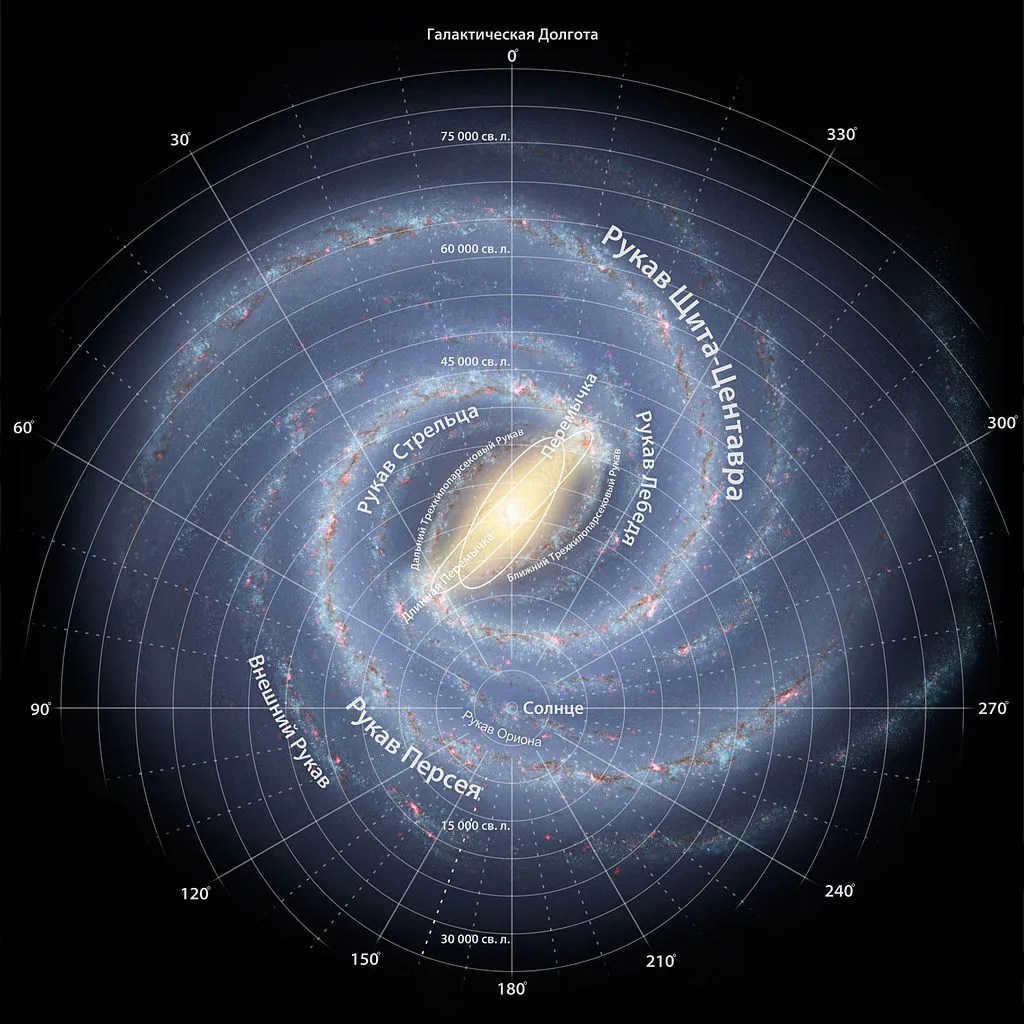
Every day, we find ourselves measuring distances in various ways: whether it’s to the nearest grocery store, to the house of a relative in a different city, and so on. However, when it comes to the vast expanses of the cosmos, it becomes clear that using familiar units like kilometers is highly impractical. It’s not just the difficulty in comprehending the resulting enormous values, but also the sheer number of digits involved. Even simply writing out the number of zeros becomes a challenge. For instance, the shortest distance between Mars and Earth is 55.7 million kilometers. That’s six zeros! And Mars is one of our closest neighbors in the sky. So how can we possibly deal with the unwieldy numbers that would arise when calculating distances to even the nearest stars? This is where a unit like the light-year comes in handy. But what exactly is a light-year? Let’s find out.
The concept of a light-year is closely intertwined with the field of relativistic physics, which emerged in the early 20th century as Newtonian mechanics began to crumble under scrutiny. This scientific discipline established a deep connection between space and time, highlighting their interdependence. Before the introduction of the light-year as a unit of measurement, larger distances were measured using different systems.

The formation of units of measurement in the metric system was quite straightforward: each subsequent unit was a multiple of a smaller unit (centimeters, meters, kilometers, and so on). However, when it came to measuring the vast distances of the universe, a new approach was needed. The concept of the light year was born from the realization that the speed of light is constant and the fastest speed allowed in modern physics. A light year represents the distance that a beam of light travels in one Earth calendar year. In terms of kilometers, it is approximately 9.46*10^15 kilometers. Interestingly, it only takes a photon about 1.3 seconds to reach the nearest moon, about eight minutes to reach the Sun, but it would take about four light years to reach the closest stars, such as Alpha Centauri.

It’s an incredible span. Astrophysics deals with even greater measurements of space. A light-year is approximately equivalent to one-third of a parsec, which is an even larger unit used to measure distances between stars.
Varying conditions affect the speed at which light travels.
By the way, there is an additional feature where photons can move at varying velocities in different surroundings. We are already aware of their speed in a vacuum. And when they refer to a light year as the distance light travels in one year, they are specifically referring to empty space. However, it is fascinating to mention that in other conditions, the speed of light can be slower. For instance, in the air medium, photons scatter at a slightly reduced pace compared to a vacuum. The specific state of the atmosphere determines the extent of this reduction. Consequently, in a gas-filled medium, the value of a light year would be marginally lower. Nonetheless, it would not deviate significantly from the accepted measurement.
One kilometer [km] is equal to 1.0570008340247E-13 light-year [sv. y.].
Value after transformation
meter exameter petameter terameter gigameter megameter kilometer hectometer decameter decimeter centimeter millimeter micrometer micron nanometer picometer femtometer attometer megaparsec kiloparsec parsec light year astronomical unit league nautical league (Brit.) nautical league (international) league (statutory) mile nautical mile (Brit.) nautical mile (international) mile (statutory) mile (U.S. geodetic) mile (Roman) 1000 yards farlong farlong (U.S. geodetic) chay. ) nautical mile (international) mile (statutory) mile (U.S., geodetic) mile (Roman) 1000 yards farlong farlong (U.S., geodetic) chane chane (U.S., geodetic) rope (English rope) genus genus (U.S., geodetic) perch pol (English pole). pole) pole, fathom fathom fathom (U.S., geodetic) cubit yard foot foot (U.S., geodetic) link link (U.S., geodetic) cubit (Brit.) hand heel finger nail inch inch (U.S., geodetic) barley grain (U.S., geodetic). barleycorn) thousandth microinch angstrom atomic unit of length x-unit fermi arpan solder typographical point tweep elbow (Swedish) naval fathom (Swedish) caliber centidinum ken arshin actus (Dr. Roman. ) vara de tarea vara conuquera vara castellana elbow (Greek) long reed reed long elbow palm "finger" Planck length classical electron radius Bohr radius equatorial radius of the Earth polar radius of the Earth distance from the Earth to the Sun radius of the Sun light nanosecond light microsecond light millisecond light millisecond light second light hour light hour light day light week light week billion light years distance from the Earth to the Moon cablet (international) cablet (British) cablet (US) nautical mile (US) light minute rack unit horizontal step cicero pixel line inch (Russian) vershok heel foot sazhen oblique sazhen versta boundary versta versta
Feet and Inches to Meters Conversion Tool
Overview
The Converter of feet and inches to meters is a handy tool that allows you to easily convert measurements between different units of length. Whether you need to convert feet and inches to meters or vice versa, this tool has got you covered!
Length, which is the greatest dimension of a body, is typically measured horizontally in three-dimensional space. On the other hand, distance refers to the quantity that determines the extent of separation between two bodies.
Understanding Measurements of Distance and Length
Distances and Lengths Measurement Units
The metric system, specifically the SI system, utilizes meters as the primary unit for measuring length. Additionally, the metric system also employs derived units like kilometers (equivalent to 1000 meters) and centimeters (1/100 of a meter). Conversely, countries like the United States and the United Kingdom, which do not adhere to the metric system, utilize units such as inches, feet, and miles to measure length.
Distance in physics and biology
In the fields of biology and physics, measurements are often taken of distances that are much smaller than one millimeter. To quantify these small lengths, a special unit known as the micrometer is used. One micrometer is equivalent to 1×10-⁶ meters. In the realm of biology, micrometers are used to measure the size of microorganisms and cells, while in the field of physics, they are used to measure the length of infrared electromagnetic radiation. The micrometer is also commonly referred to as a micron and is sometimes symbolized by the Greek letter µ in English-language literature. There are several other derivatives of the meter that are widely utilized, including nanometers (1×10-⁹ meters), picometers (1×10-¹² meters), femtometers (1×10-¹⁵ meters), and attometers (1×10-¹⁸ meters).
Distance measurement in navigation
In navigation, nautical miles serve as the standard unit of measurement. A nautical mile is equivalent to 1,852 meters. Initially, it was determined by measuring an arc of one minute along the meridian, specifically 1/(60×180) of a meridian. This method simplified latitude calculations since 60 nautical miles equaled one degree of latitude. When it comes to measuring distance in navigation, speed is commonly expressed in nautical knots. A nautical knot signifies a speed of one nautical mile per hour.
When it comes to astronomy, the measurement of long distances requires the use of specialized units to simplify calculations.
The astronomical unit (a. e., au) is defined as 149,597,870,700 meters. This value remains constant and is considered the standard distance from the Earth to the Sun.
On the other hand, a light year is equivalent to 10,000,000,000,000,000,000 or 1018 kilometers. It represents the distance that light can travel in a vacuum within one Julian year. While this measurement is commonly found in popular scientific literature, it is not as frequently used in the fields of physics and astronomy.
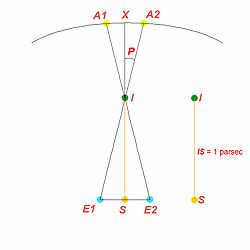
- A1, A2: the visible location of the star
- E1, E2: the Earth’s position
- S: Sun’s position
- I: point of intersection
- IS = 1 parsec
- ∠P or ∠XIA2: angle of parallax
- ∠P = 1 arc second
Other units
League – An outdated unit of measurement once utilized in numerous countries. Certain regions still employ it, such as the Yucatan Peninsula and rural Mexico. It represents the distance traveled by a person in an hour. A nautical league is equivalent to three nautical miles, approximately 5.6 kilometers. A lieu is a unit roughly equal to a league. In English, both leagues and leagues are referred to as league. In literature, leagues are occasionally mentioned in book titles, like 20,000 Leagues Under the Sea, a renowned novel by Jules Verne.
Elbow is a measurement that has been used since ancient times and is equal to the distance from the tip of the middle finger to the elbow. This unit of measurement was widely used in the ancient world, during the Middle Ages, and continues to be used in modern times.
Yard is a unit of measurement in the British imperial system and is equivalent to three feet or 0.9144 meters. In some countries, like Canada, which has adopted the metric system, yards are still used for measuring fabrics and the length of swimming pools and sports fields, including golf and soccer fields.
Definition of meter
The definition of a meter has undergone multiple changes over time. Initially, it was established as 1/10,000,000 of the distance between the North Pole and the equator. Subsequently, it was redefined as the length of a platinum-iridium standard. Later on, it was linked to the wavelength of the orange line in the electromagnetic spectrum of ⁸⁶Kr, a krypton atom, in a vacuum, multiplied by 1,650,763.73. Presently, a meter is defined as the distance that light travels in a vacuum in 1/299,792,458 seconds.
Calculations
In the field of geometry, the calculation of the distance between two points, A and B, with coordinates A(x₁, y₁) and B(x₂, y₂), can be done by using the following formula:
By applying this formula, you will obtain the result within a matter of minutes.
The Length and Distance Converter on our website utilizes the unitconversion.org functions to carry out unit conversion calculations.
In earlier times, the primary approach to measuring cosmic distances involved the horizontal parallax method. Although this method is highly accurate and is still employed for determining distances to extremely distant celestial objects, a more straightforward and even more precise method known as radiolocation has been utilized since the mid-20th century for measuring distances to nearby planets within our solar system.
The precise knowledge of the speed at which radio waves travel allows for the accurate measurement of the time it takes for the waves to be sent and received. By determining the distance covered by the waves during their round trip, the distance to Venus can be determined with much greater accuracy compared to the parallax method.
Since 1961, this method has become the primary means of measuring short distances in space. Based on the data obtained, scientists have calculated that the average distance from Earth to the Sun is 149,573,000 km.


Radio telescopes continuously scan the vastness of space and capture the echoes of their signals bouncing off celestial objects
The measurement of cosmic distances: from light seconds to light years
When it comes to measuring distances within our solar system, it is most convenient to use the Keplerian scheme, where the Sun is at the center and the planets revolve around it. This allows us to calculate distances not from the Earth, but from the Sun itself. But what units of measurement should be used?
- One option is to express distances in millions of kilometers. Kilometers are a commonly used unit for measuring large distances.
- Next, in order to avoid using large numbers such as millions of kilometers, we can make the assumption that the average distance between the Earth and the Sun is defined as one astronomical unit (abbreviated as “au”). This allows us to express distances in terms of au, with 1 au being equivalent to 149,500,000 kilometers. To simplify, we can round 1 au to 150,000,000 km.
- Additionally, we can also express distances using the time it takes for light (or any other similar form of radiation, such as radio waves) to travel. The speed of light in a vacuum is approximately 299,776 km/second. For simplicity, this can be rounded to 300,000 km/second.
We could reasonably assume that a light hour equals one billion kilometers.
Considering this, let’s examine the planets that were familiar to the ancient people and compile a table showing their average distances from the Sun in each of the three mentioned units.
| Planets | Average distance from the Sun | ||
| millions of kilometers | astronomical units | light hours | |
| Mercury | 57.9 | 0.387 | 0.0535 |
| Venus | 108.2 | 0.723 | 0.102 |
| Earth | 149.5 | 1.000 | 0.137 |
| Mars | 227.9 | 1.524 | 0.211 |
| Jupiter | 778.3 | 5.203 | 0.722 |
| Saturn | 1428.0 | 9.539 | 1.321 |


During his time, William Herschel expanded the frontiers of knowledge by making the groundbreaking discovery of Uranus and effectively expanding the boundaries of the solar system.
The dimensions of the solar system
During the 17th century, astronomers believed that the orbit of Saturn marked the outer limit of the Solar System. They thought that the entire system could fit within a circle with a diameter of 3 billion kilometers.
However, in 1781, the discovery of Uranus by the English astronomer, William Herschel (1738-1822), revealed that the diameter of the Solar System was actually much larger, as it suddenly doubled in size.
And then it doubled again when the French astronomer Urbain Joseph Leverrier (1811 – 1877) discovered Neptune in 1846, and later when the American astronomer Clyde William Tombaugh (b. 1906) discovered Pluto in 1930.
| Planets | Average distance from the Sun | ||
| millions of kilometers | astronomical units | light hours | |
| Uranus | 2872 | 19,182 | 2,63 |
| Neptune | 4498 | 30,058 | 4,26 |
| Pluto | 5910 | 39,518 | 5,47 |
If we take into account the path of Pluto, previously Saturn’s path, we can observe that the size of the solar system is not 3, but rather 12 billion kilometers. A beam of light that covers the same distance as the Earth’s circumference in 1/7 of a second and travels from Earth to the Moon in 1 1/4 seconds would require half a day to traverse the solar system.
Furthermore, there are compelling indications that Pluto’s orbit does not represent the boundary of the Sun’s realm. This does not imply that we should assume the existence of yet undiscovered planets that are even farther away (excluding dwarf planets). There are already known celestial bodies that are occasionally visible and undoubtedly travel much farther from the Sun than Pluto does at the farthest point of its orbit.
What are the limits of the solar system?
In 1684, the law of universal gravitation was discovered by the renowned English scientist, Isaac Newton (1642-1727). This groundbreaking law provided a rigorous mathematical basis for the Keplerian model of the solar system, enabling the calculation of the orbit of any celestial body orbiting the Sun, even if it was only observed during a portion of its orbit.
Consequently, this breakthrough allowed astronomers to study comets, which are celestial bodies that occasionally make appearances in the sky. In ancient times and during the Middle Ages, it was commonly believed that comets appeared randomly and that their movement was not governed by any natural laws. The general public held the belief that comets were omens of misfortune.
However, Edmund Halley, an English scientist and contemporary of Newton, attempted to utilize the law of gravity in relation to comets. He observed that certain comets with exceptional brightness would appear in the sky every 75-76 years.
In 1704, Halley proposed the idea that all of these comets were actually a single celestial object that traveled in a consistent elliptical orbit around the Sun. This orbit was highly elongated, with a significant portion of it located at a tremendous distance from Earth. When the comet was far away from Earth, it would be undetectable.
Yet, every 75 or 76 years, the comet would reach the closest point in its orbit to the Sun (and Earth), resulting in its visibility.


An effort to depict the real sizes and distances between the planets in the solar system
Halley made calculations about the path of this comet and predicted its return in 1758. True to his prediction, the comet reappeared that year (16 years after Halley’s death) and has since been known as Halley’s Comet.
When Halley’s Comet is at its closest point to the Sun, it is approximately 90,000,000 km away, which is slightly inside the orbit of Venus. On the other hand, when it is at its farthest point from the Sun, it is about 3 1 / / times farther away than Saturn. 2 times farther away than Saturn.
Therefore, astronomers already knew by 1760 that the solar system extends beyond the orbit of the “last” planet.
In addition, Halley’s Comet is one of the comets that orbits relatively close to the Sun. There are other comets that have incredibly elongated orbits and only return to the Sun once every few centuries or even millennia. These comets travel not just billions of kilometers away from the Sun, but most likely hundreds of billions.
It can be inferred that the solar system’s maximum diameter may be as large as 1,000 billion, equivalent to a trillion (1,000,000,000,000,000,000) kilometers or potentially even larger. It takes 40 days for a beam of light to traverse such a vast distance. Therefore, we can conclude that the solar system’s diameter surpasses that of one light month.
Geography 5 Klimanova §2 “Stars and Galaxies.” An online edition is available for preview and purchase of the textbook “Klimanova, Klimanov, Kim: Geography. Earth science. 5-6 kl.” Quotations from the 2012 textbook are being used for educational purposes in the context of family, correspondence, and distance learning.
Grade 5 Geography. UMK Klimanova § 2.
§ 2. Stars and galaxies
Arcturus, Vega, Sirius, Deneb, Betelgeuse…. Only a small number of the numerous stars that can be seen from Earth have their own names, but each star possesses its own unique characteristics: such as temperature, size, history, and behavior … Not all celestial bodies that emit light are actually stars, as some are massive clusters of stars that exist at great distances from Earth. The Sun, which is the closest star to Earth, is also the brightest object in our sky.
What exactly is a star?
The concept of stars as we know them today emerged in the early 20th century. Scientists propose that stars are actually spherical masses of hot gas. Stars emit light and heat due to the occurrence of chemical reactions that create elements within their core.
Factories of stars
Every living thing on our planet, including humans, as well as other planets and stars in the universe, is composed of chemical elements. Currently, there are approximately 110 known chemical elements.
The Earth is primarily made up of compounds containing silicon and iron. Living organisms, including humans, mainly consist of compounds containing oxygen, carbon, hydrogen, and nitrogen. All of these chemical elements originated within stars. Therefore, all of us, humanity, are not only figuratively, but also literally, descendants of the Sun.
Discover and examine the table that displays the chemical elements known to mankind – the Periodic Table of Chemical Elements. It is named after the Russian scientist Dmitri Ivanovich Mendeleev (1834-1907), who established the rules for organizing the elements in the table.
Which element holds the number 1 position in the table? This element is the most abundant in the universe and serves as the foundation for other elements within the interior of stars.
N. Copernicus believed that every star was equidistant from Earth, but this assumption has proven to be incorrect.
The distances to the visible stars were determined through a unique methodology (Fig. 4). It was discovered that each star is actually situated at a different distance from Earth. These distances are so vast that a specialized unit of measurement, known as the light-year, was introduced. A light-year represents the distance that light can travel in one year, moving at the fastest speed possible in the Universe, which is 300,000 kilometers per second. For instance, it takes approximately 8 minutes for light from the Sun to reach Earth (you can calculate the distance between Earth and the Sun in kilometers). Meanwhile, the nearest known star is located more than four light-years away.
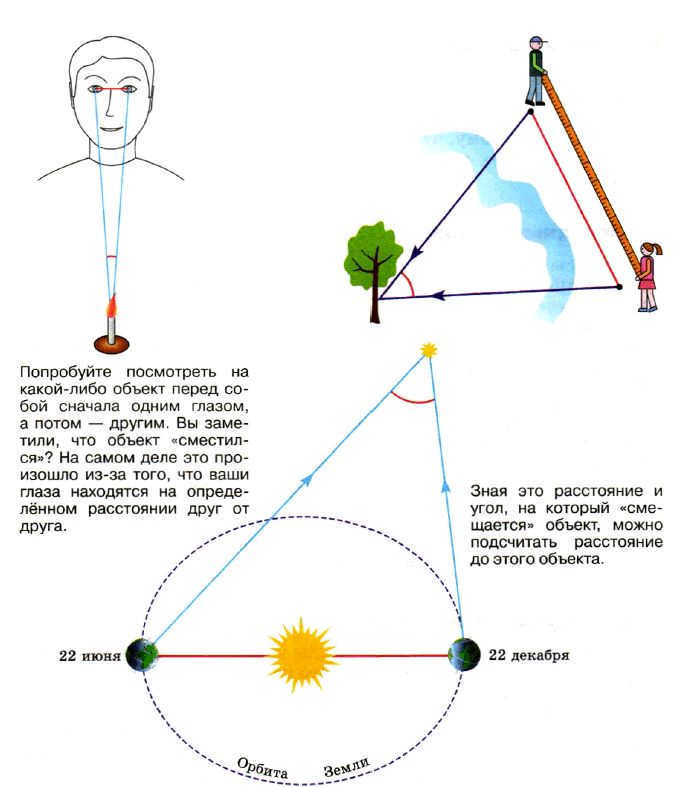
As the Earth orbits the Sun, it completes one revolution every year. This motion causes the stars in the sky to appear to move. By measuring the angle of displacement of a star, it is possible to calculate its distance. This method is also used to determine the distances to objects that are inaccessible on Earth.
What are the various types of stars?
Stars can be differentiated by their color, luminosity, and size (Fig. 5).
The color of a star is determined through observation and is dependent on the star’s temperature. Blue stars have the highest temperature, while reddish stars have the lowest temperature. Even stars with the lowest temperature are still incredibly hot, with red stars reaching temperatures of approximately +2500 °C.
Luminosity refers to the radiative power of a star and is determined by comparing it to the Sun, which has a luminosity of one. Some stars have luminosity that far exceeds that of the Sun, while others have significantly lower luminosity.
The size of stars, along with their temperature and brightness, varies greatly. There are different types of stars, including dwarf stars, giants, and supergiants. Dwarfs have a diameter of thousands of kilometers, while supergiants have a diameter of millions of kilometers. Some stars have the ability to change their size.
The color, brightness, and size of a star can change at different stages of its life. Blue stars are the youngest, while red stars are the oldest. For example, our Sun will first expand and become a red giant at the end of its life, and then eventually become a white dwarf. The lifespan of a star is determined by its mass: the larger the mass, the shorter the lifespan. Supergiants can live for millions of years, while stars like our Sun can live for billions of years.
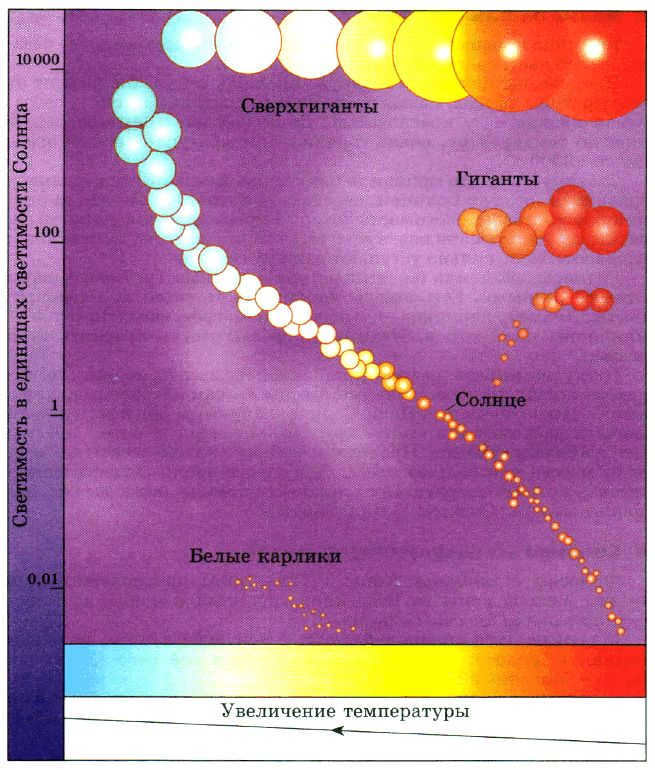
Task for Figure 5 on page 18:
Find the position of the Sun in the sequence of stars based on temperature, brightness, and size. Would it be possible for Earth to exist if the Sun were a red supergiant or a white dwarf?
Philosopher Immanuel Kant (1724-1804) proposed the idea that stars are organized into clusters in the Universe, and one of these clusters is known as the Milky Way. The Milky Way.
The Milky Way can be observed on a clear night without the presence of the moon as a faint band stretching across the sky (Milky Way – Milky Way). Through a telescope, it becomes apparent that this band is comprised of numerous stars. The Milky Way is a galaxy (derived from the Greek word “galaktikos” meaning milky) (Fig. 6).
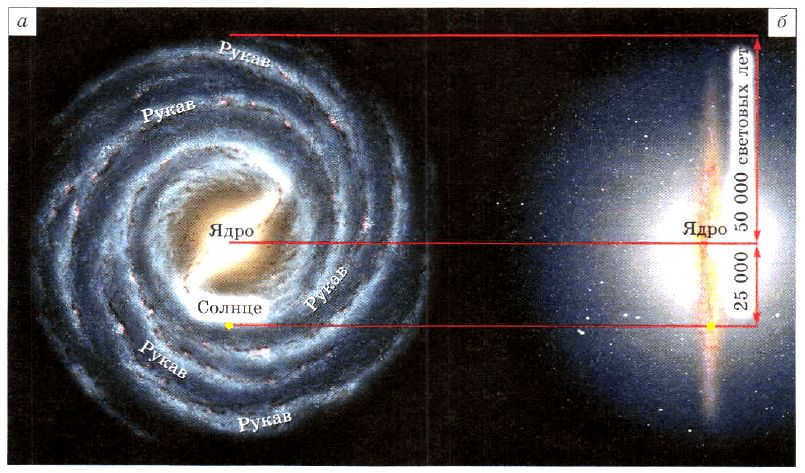
Task for Fig. 6 on page 19:
Compare the Galaxy’s diameter and thickness. Locate the Sun in both illustrations.
The Sun is just one of over 200 billion stars in the Milky Way Galaxy. within the Milky Way Galaxy. There are galaxies that contain trillions of stars. “As numerous as the stars in the sky,” the ancient people would say, emphasizing the vast quantity of something, and, as it turns out, they were correct. “As numerous as the galaxies in the sky,” the present-day scientists would declare, and they are indeed correct.
What is the method of observing the distant past?
Once telescopes with sufficient power became available, scientists discovered that many stars are actually massive clusters known as galaxies. It is astonishing to think about how far these galaxies are from Earth! For example, the Small Magellanic Cloud, one of the closest galaxies to us, is located 170,000 light years away. The Andromeda Nebula, another well-known galaxy, is even further at a distance of 2 million light years. Some galaxies are so far away that the light we see from them has been traveling for billions of years! This incredible fact means that when we observe galaxies, we are essentially looking back in time to the distant past of the Universe. The further away a galaxy is, the further back in time we are able to see.
Due to the expansion of the Universe, the distance between galaxies is constantly increasing. As a result, galaxies that are farther away from Earth are moving away from us at a faster rate.
CONCLUSIONS.
Our planet and all its living creatures owe their existence to the Sun, which is one of the stars located in the Milky Way Galaxy. The Sun has remained a stable star throughout its billions of years of existence, maintaining its size and luminosity. Due to its substantial mass, the Sun will continue to “live” for billions of years to come. However, not all stars in the universe possess these unique characteristics, making it unlikely for them to have planets, let alone habitable ones. The question of whether intelligent life exists in our Galaxy or other star systems remains a source of concern for many individuals on Earth, but it is a query that may only be answered by future generations.
Key words and expressions: – Star – Galaxy – Light-year.
Queries and assignments
- What knowledge have you gained concerning stars and galaxies from this passage? Complete the sentence, “I am aware that…”
- What inquiries did you have about stars and galaxies after reading this paragraph? Attempt to discover answers to them from various additional sources of information – books, magazines, the Internet. Prepare a brief report (no more than ten sentences) about the object or phenomenon that piques your interest. You can accompany your report with a computer presentation.
- In ancient times, individuals classified the stars visible in the sky into groups known as constellations. Do constellations genuinely exist? Substantiate your claim verbally or with the aid of a drawing.
- Why is it important for people to possess knowledge about stars, galaxies, and the Universe? Do you personally require this knowledge? Why?
Check out the electronic appendix. Stars and galaxies
You were examining: Geography 5 Klimanova §2 online edition for reviewing and buying the textbook “Klimanova, Klimanov, Kim: Geography. Earth science. 5-6 kl”.
Related Posts
Geography 5 Alekseev §7
Geography 5 Alekseev §7
Discover the online edition of the textbook “Alekseev, Nikolina, Lipkina” for Geography 5 Alekseev §7 “Earth Movements”.
Geography 5 Alekseev §6
Geography 5 Alekseev §6
Explore the digital version of the textbook “Alekseev, Nikolina” for Geography 5 Alekseev §6 “We in the Universe”.

